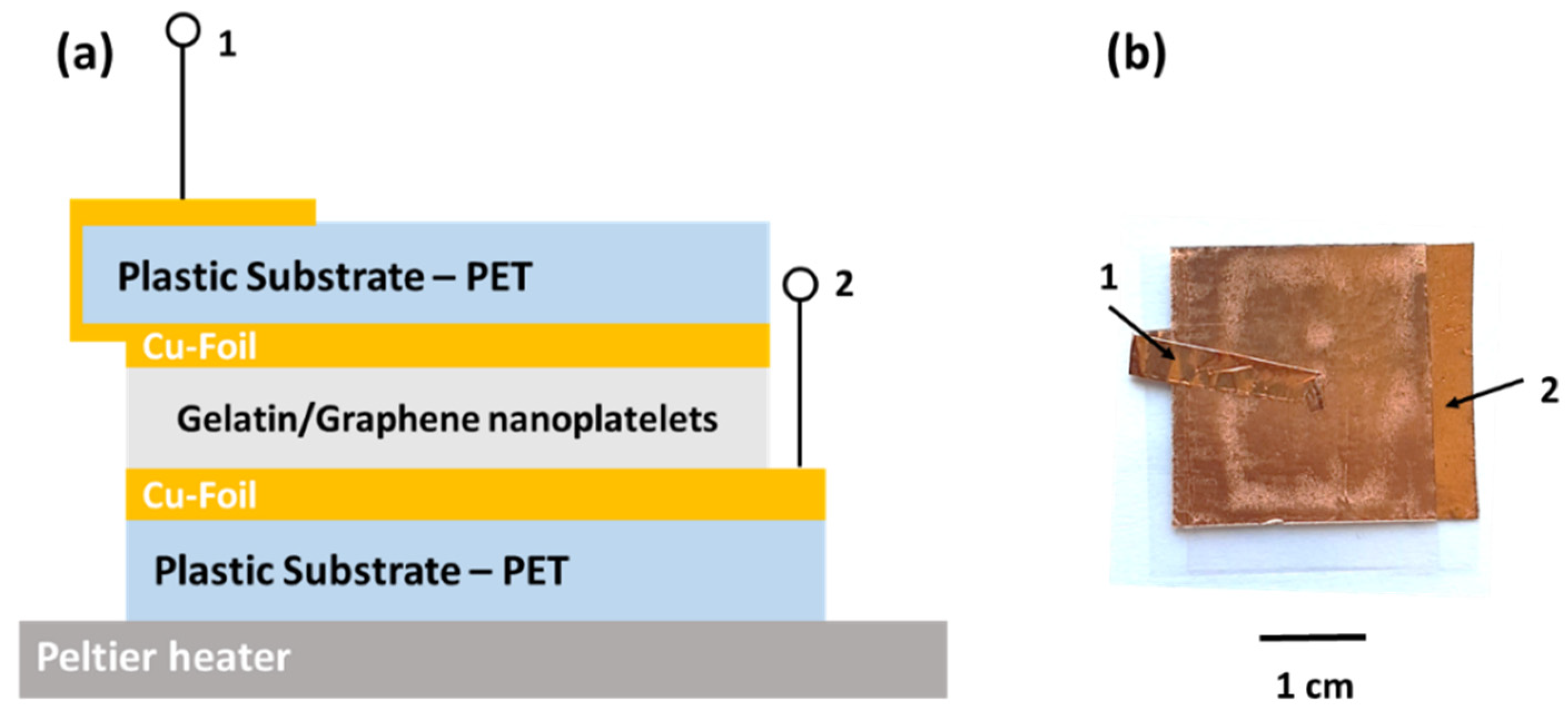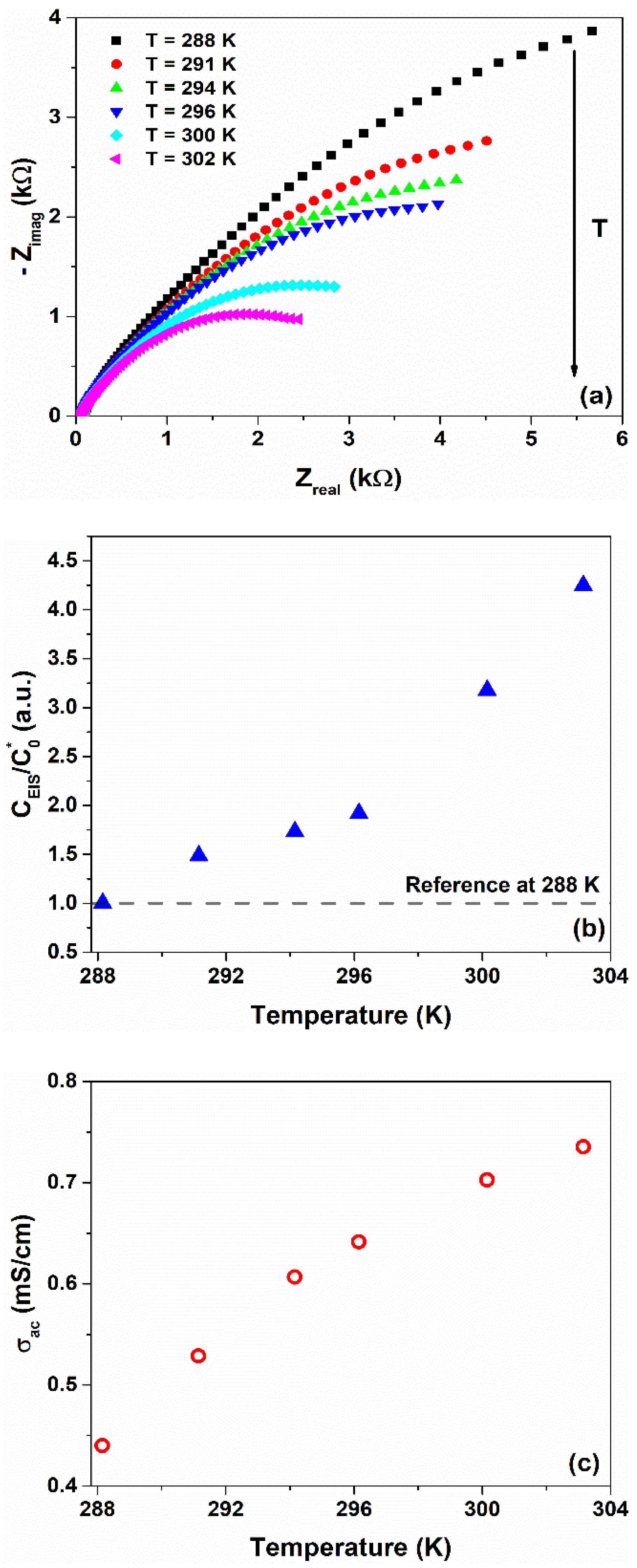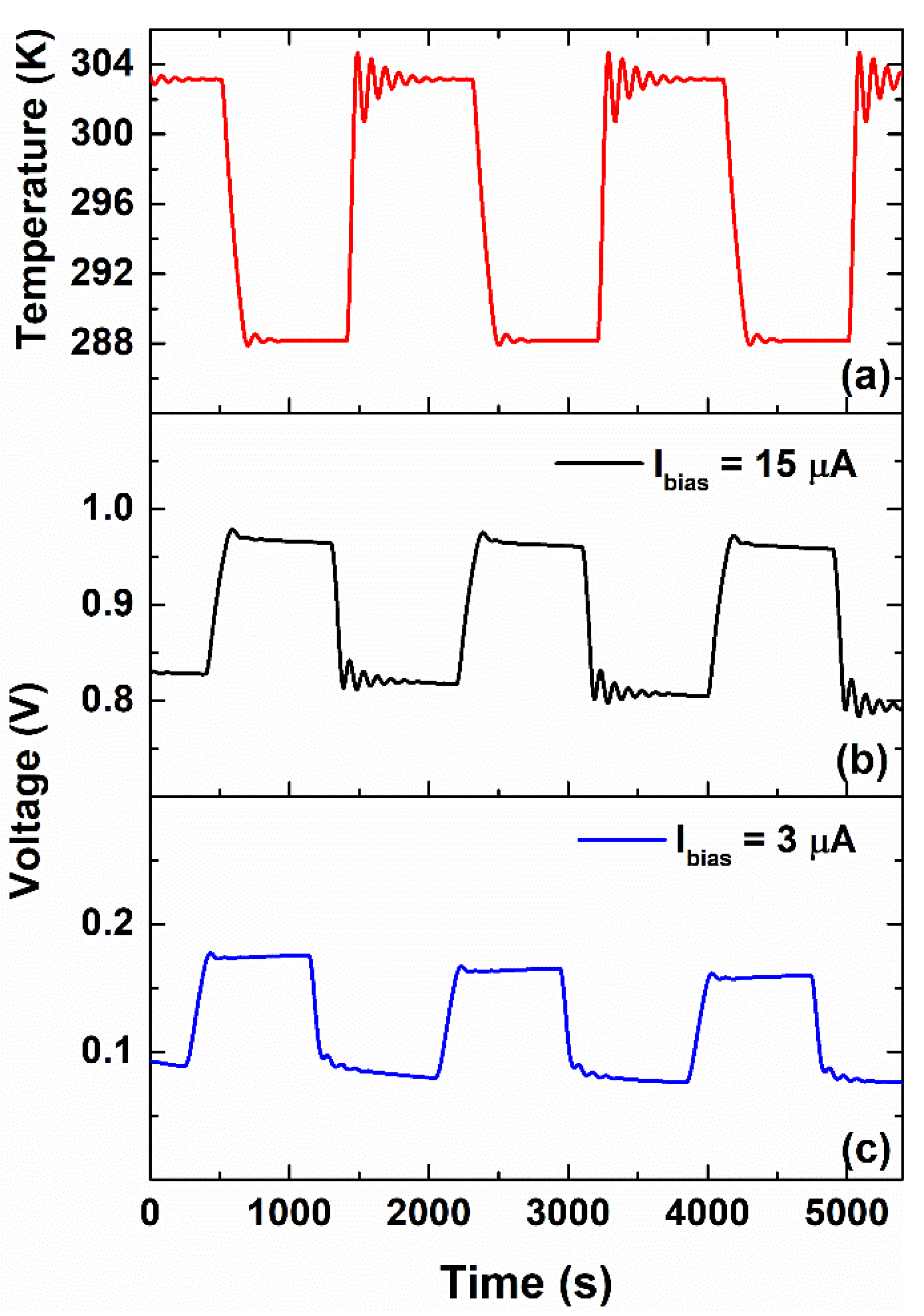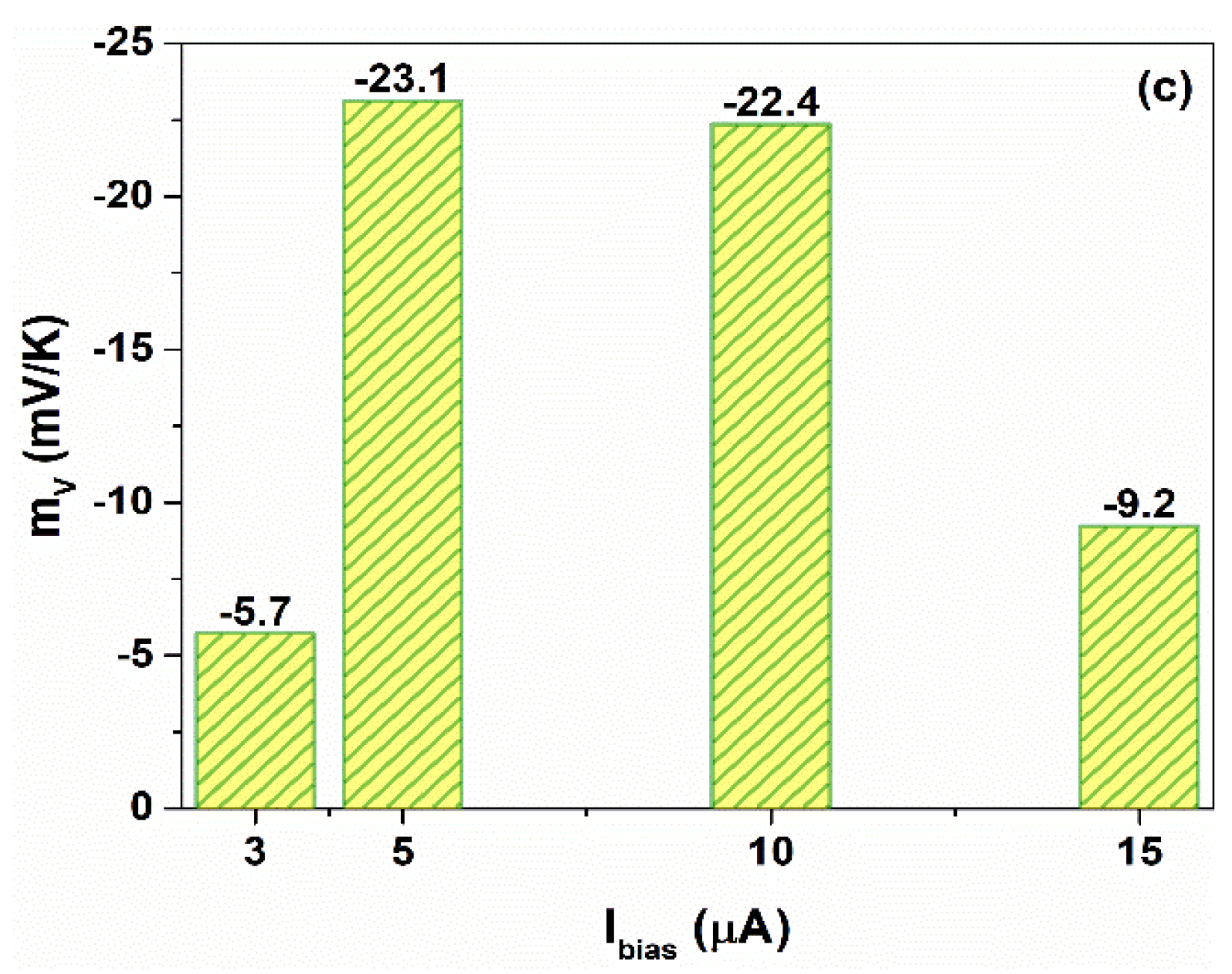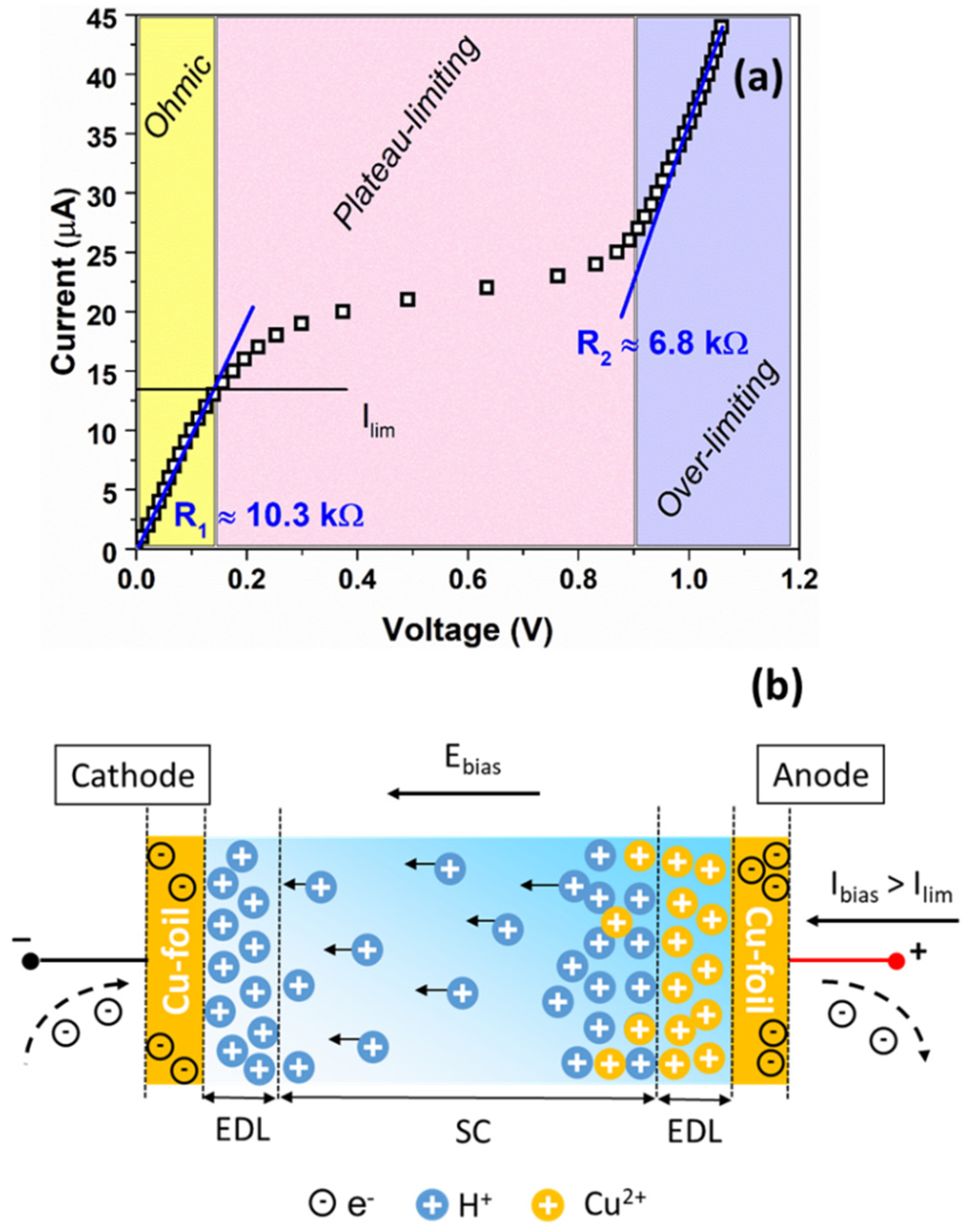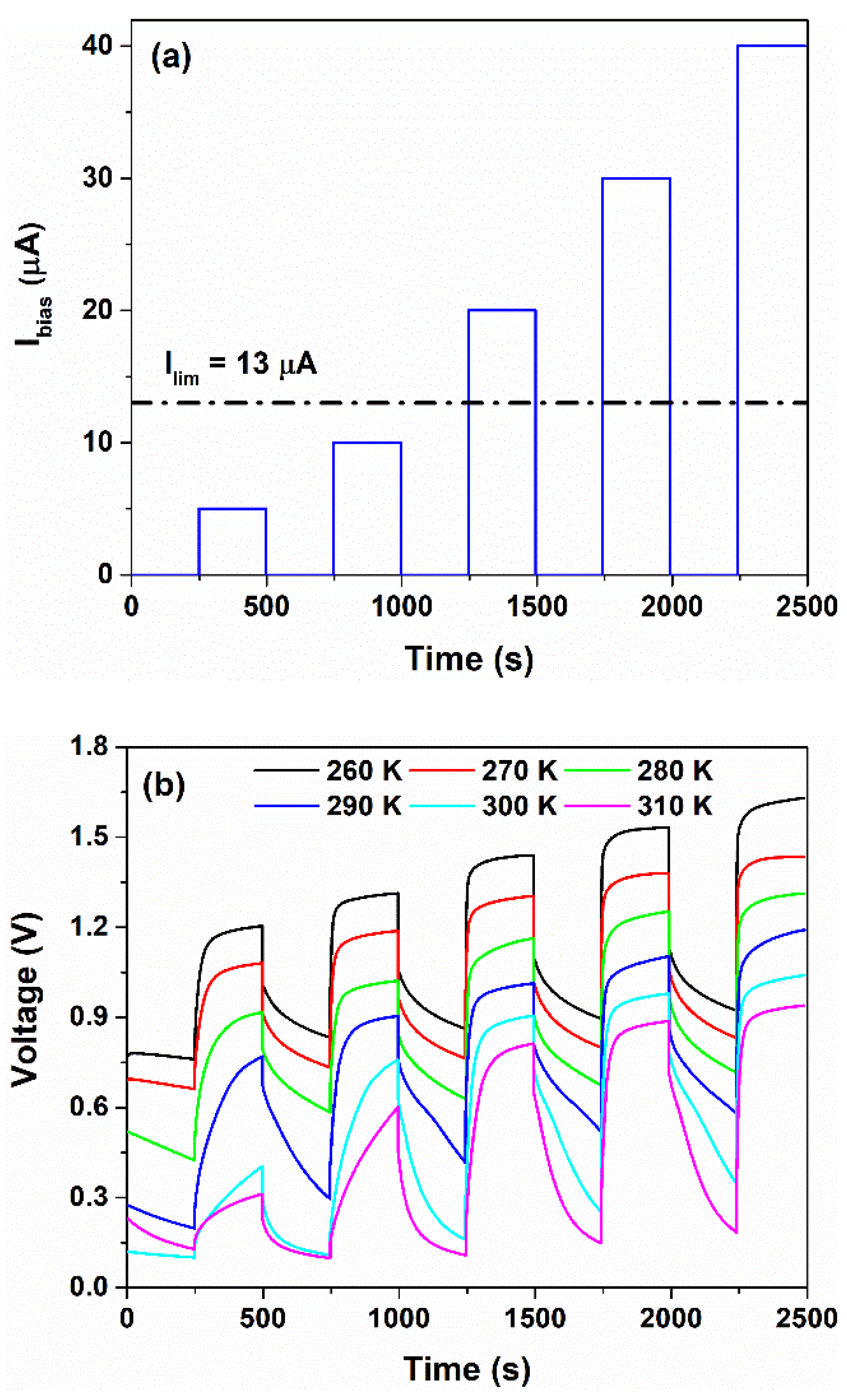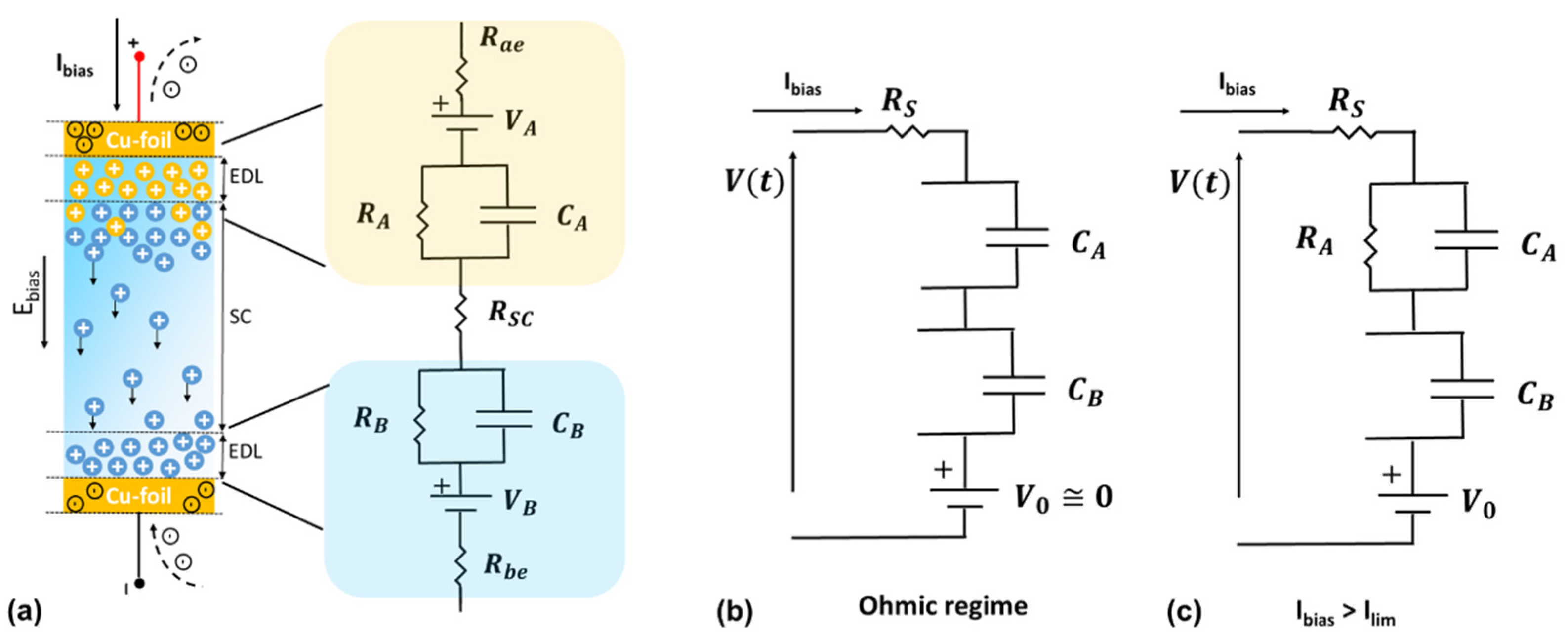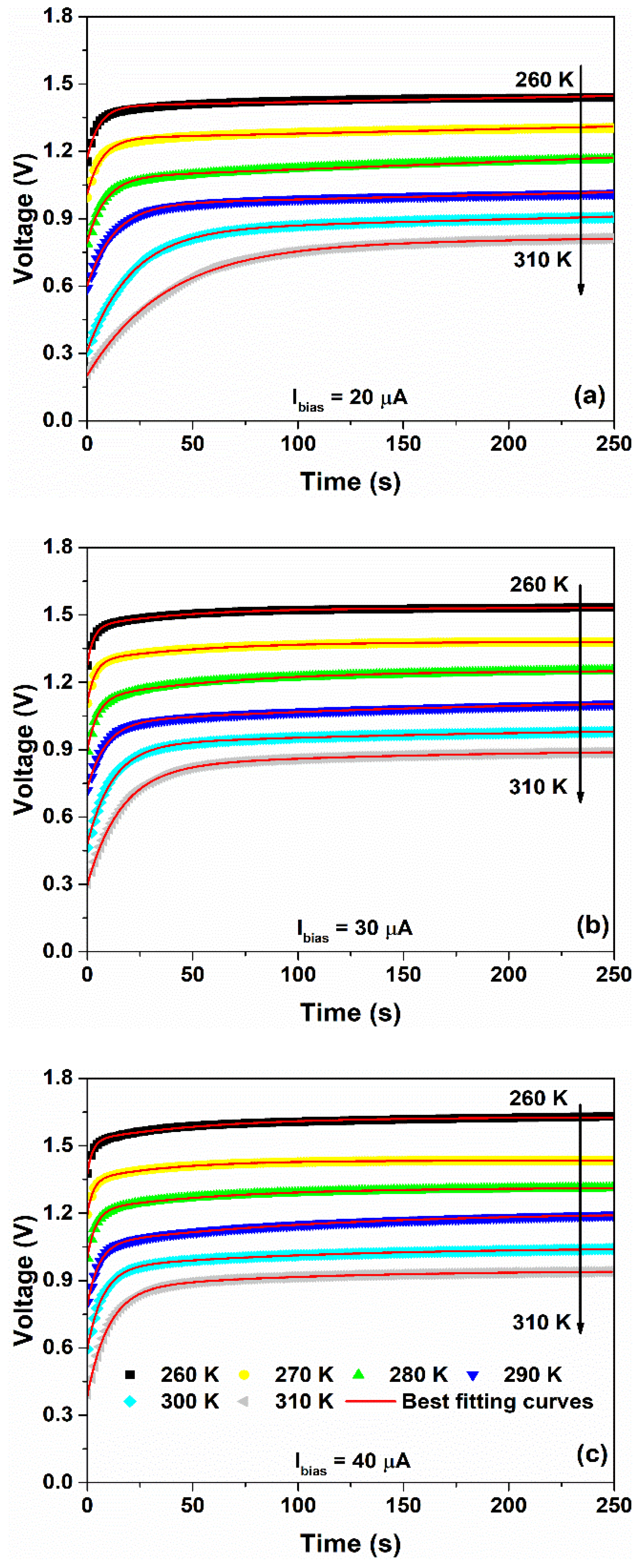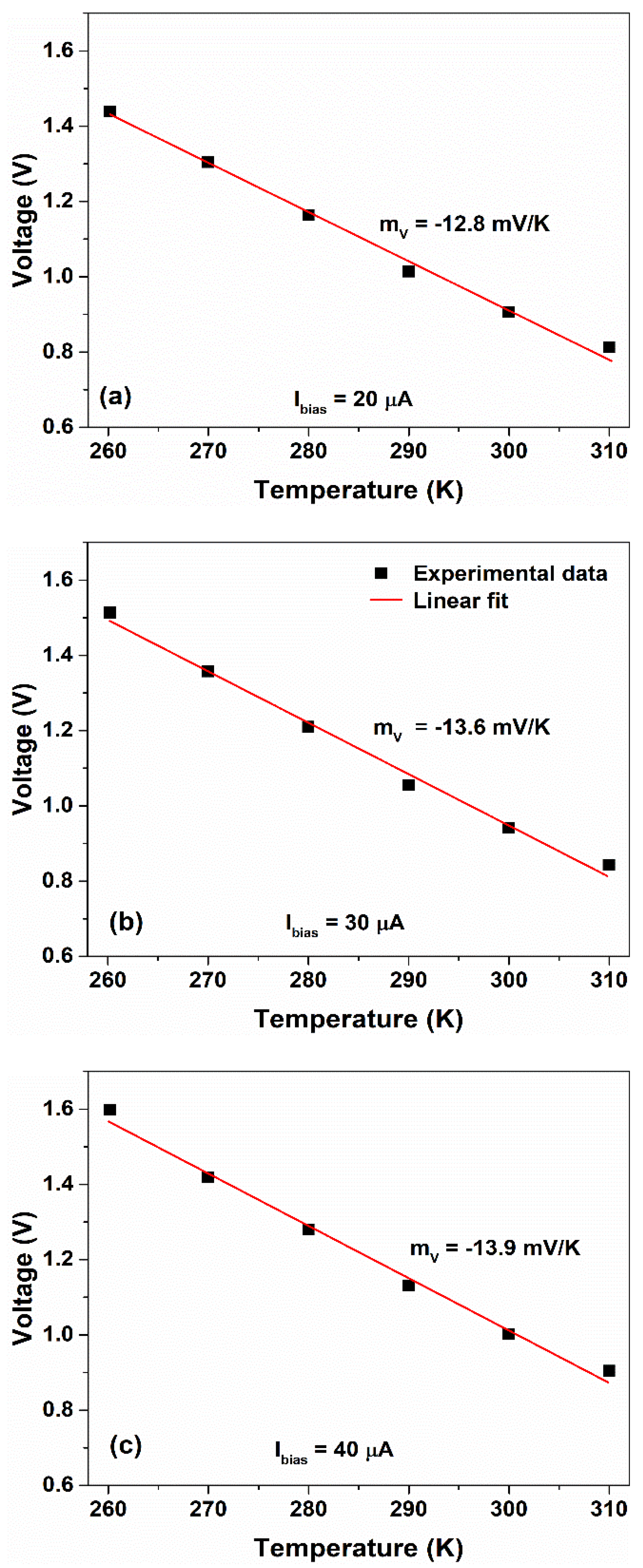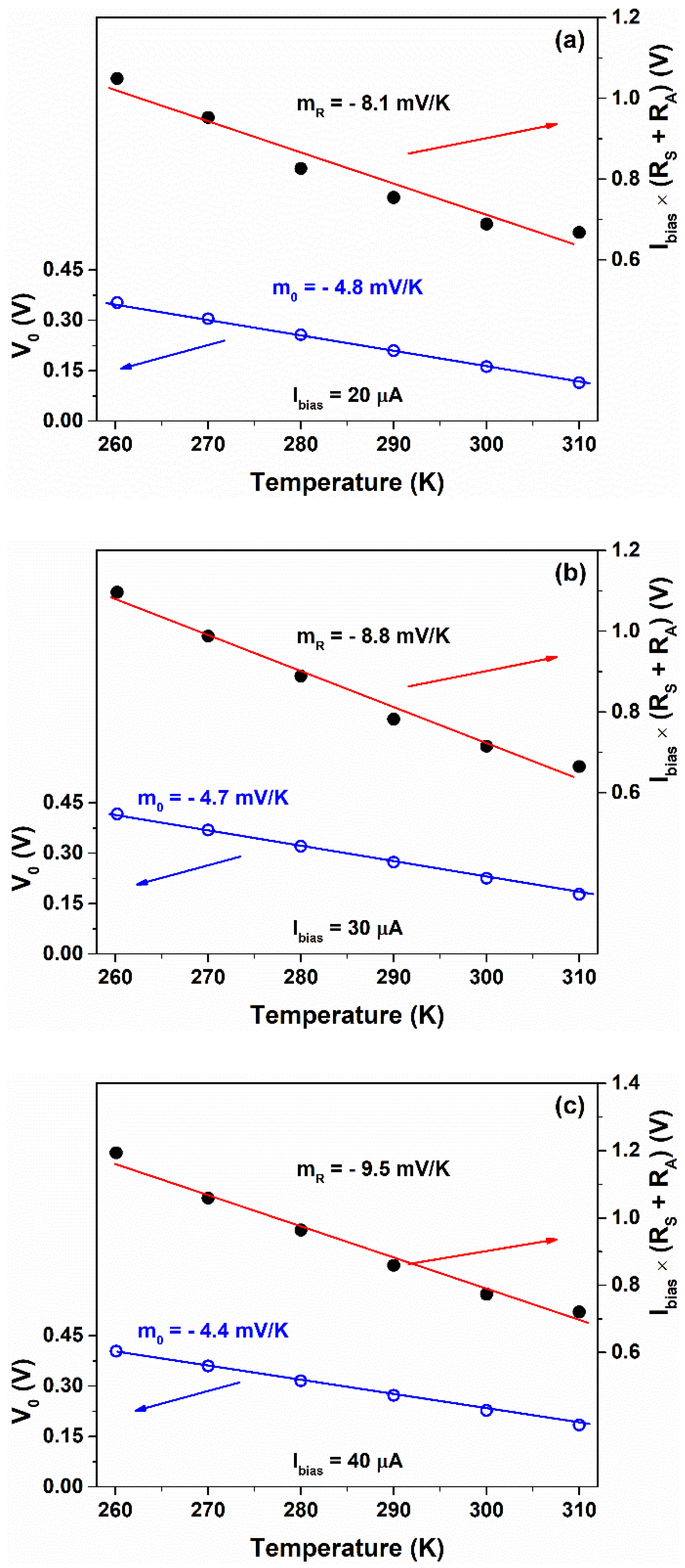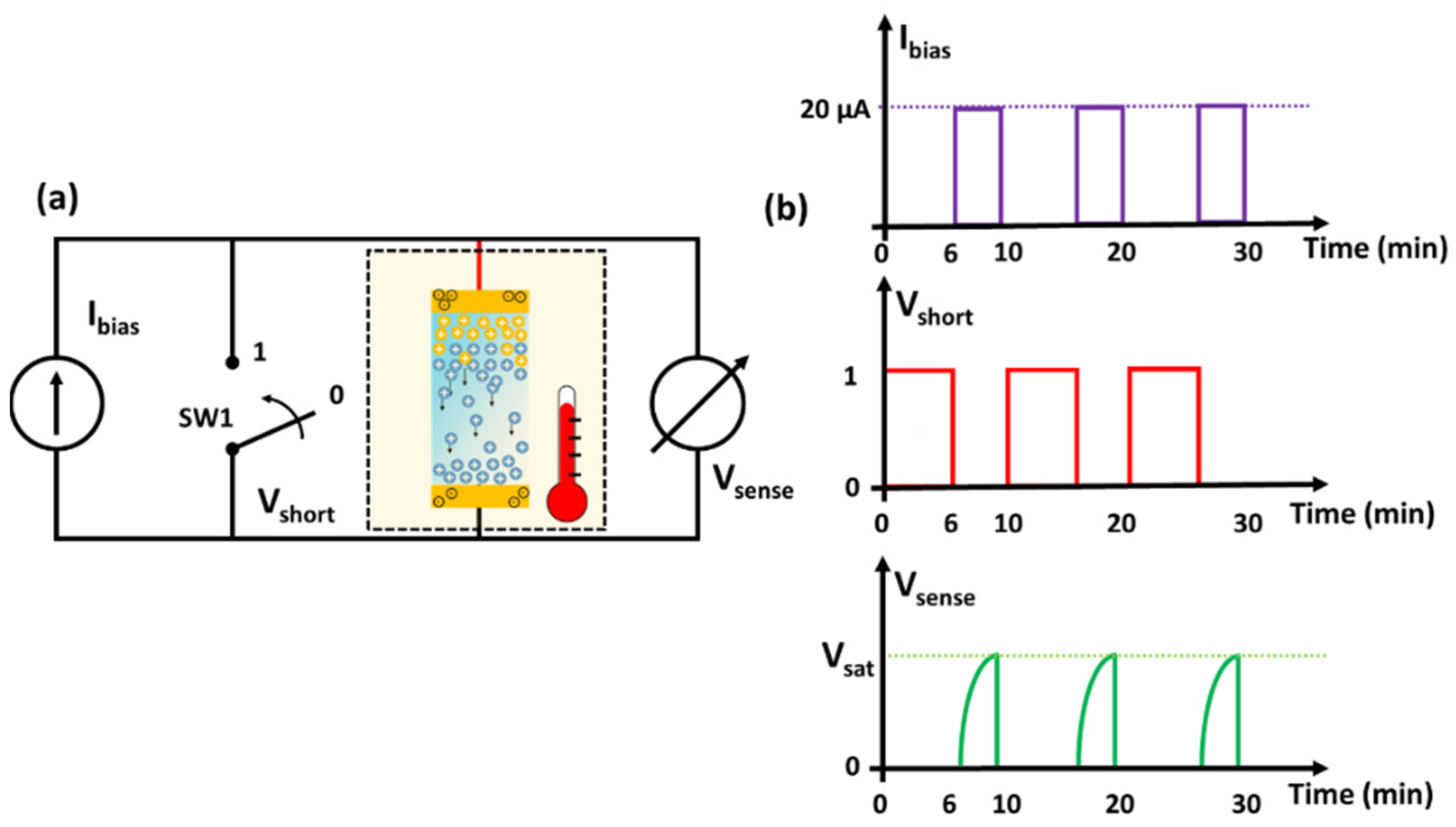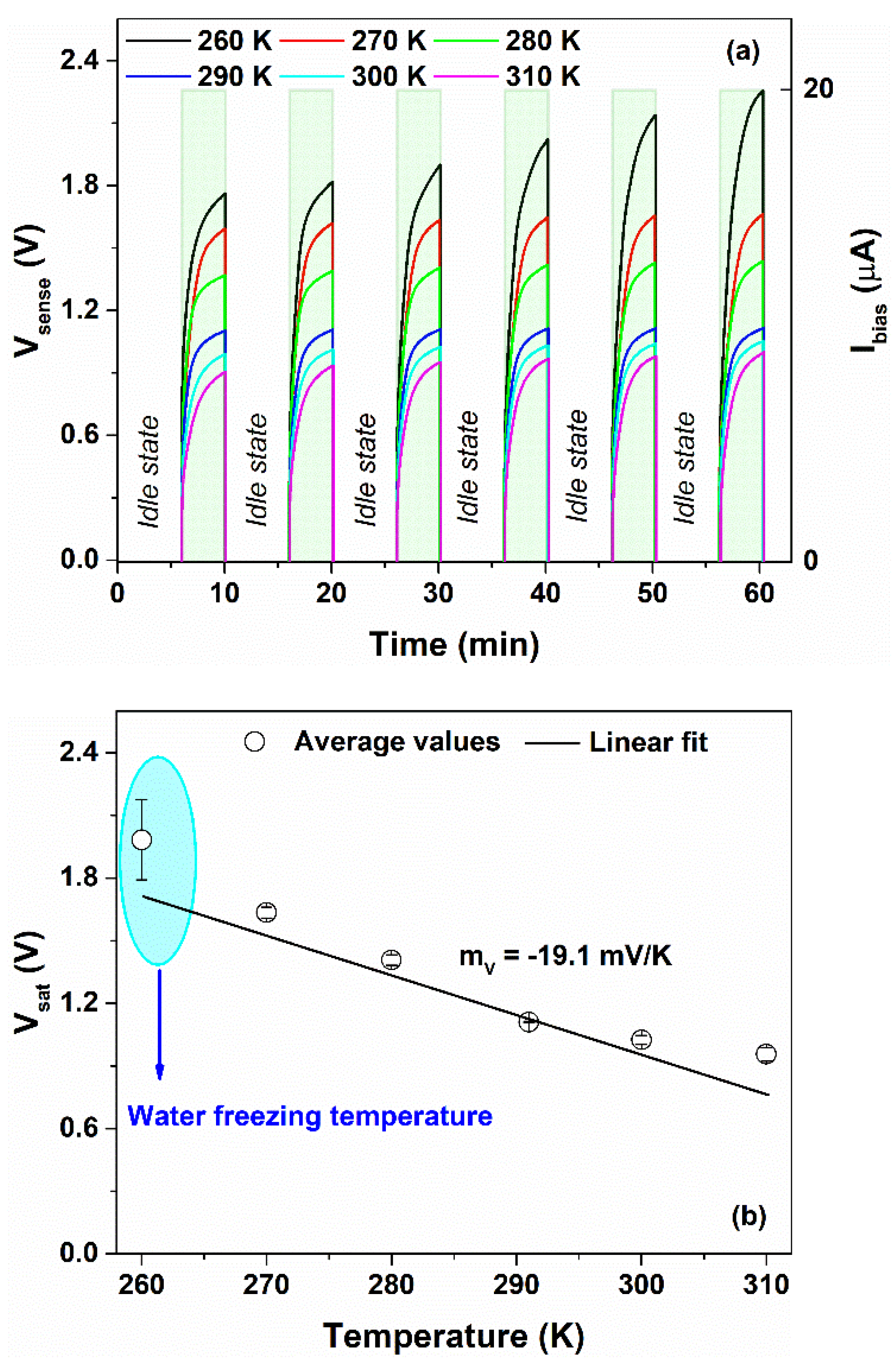Figure 1a shows the cross-section of the device formed by a symmetric sandwich structured following the layer sequence: PET substrate/Cu-Foil/Gelatin-graphene nanoplatelets. The thickness of the active layer, based on a blend of gelatin and graphene, is about 1800 µm. The gelatin/graphene system exhibits a layered and homogeneous morphology giving evidence of the good dispersion of the filler [
11,
12]. As reported in the literature, the 2D band shape from the Raman spectra indicates the presence of few-layer graphene flakes with an average of 10–15 atomic layers corresponding to cluster dimension in the range between 15–20 nm [
11]. In
Figure 1b, the image of the final device before the experimental characterization is shown. The use of a low amount of graphene as filler permits the dielectric properties of the active material to be enhanced compared to the pure gelatin, reaching an electrode specific capacitance value of about 380 F/g [
11]. In particular, the conductive filler strongly influences the reaction kinetics between the electrode and the biopolymer [
12]. This finding has been observed—after electrical oxidation at the anode contact occurs—within the blend when a bias voltage has been applied. It is worth noting that, to ensure an environmentally safe and easily disposable device, any ionic components that may adversely affect the environment have been avoided. Here, the gelatin acts as a binder for holding together the hydrophobic filler with the water–glycerol molecules and as a solid electrolyte when being a protonic conductor [
32].
3.1. Temperature Dependence of Electrical Characteristics
The temperature (
) response of the investigated electrochemical devices is influenced by the charge accumulation, faradaic charge transfer and diffusion mechanisms within the bulk and at the metal/gel nanocomposite interfaces, respectively. To highlight these contributions, cyclic voltammetry and impedance measurements have been performed in a temperature range between 288 and 303 K.
Figure 2a,b shows the CV loops, measured at 20 and 300 mV/s, corresponding to a slow and fast charge carrier dynamic, respectively. For both the
υ-values, the temperature influences the shape of the CV curves. As
T increases, the hysteresis loop increases, suggesting that the dielectric properties of the blend are sensitive to the temperature variation
. By taking into account Equation (1), the
C values can be computed.
Figure 2c shows the normalized capacitance
in temperature for lower (20 mV/s) and higher (300 mV/s) scan-rate values. Here,
is the capacitance value at 288 K (15 °C) for both the
υ-values computed from the CV curves, respectively. As can be seen, the sample exhibits a positive temperature coefficient of the capacitance (
TCC) defined as
, where
represents the capacitance variation induced by
. The resulting values are 8.3 %/K and 4.6 %/K at 20 and 300 mV/s, respectively. A higher value of
TCC observed for a lower scan rate suggests that polarization phenomena, due to the ion accumulation at the metal/gel interface, occur in the device when a temperature variation is applied along with the thickness.
Similar to the CV measurements, this temperature dependence has been also observed in the impedance spectra measurements.
Figure 3a shows the Nyquist plots—presenting the imaginary part, −
Zimag, as a function of the real part,
Zreal, of the complex impedance in the temperature range investigated. As can be seen, the diameter of the semicircle loop reduces with the increase in the temperature. By taking into account the simplified ac R-C model described by Equation (2), the diameter can be associated with the interface resistance where faradaic reactions occur [
33]. This means that the temperature variation produces some electron-transfer redox through reaction in the device.
Figure 3b shows the temperature dependence of the ratio
, where
is the capacitance extracted by using Equation (3) from the impedance data at a lower frequency (e.g., 0.1 Hz) and at open-circuit voltage. Here,
corresponds to a reference value of
at 288 K. At low frequency, the contribution of the interfacial charge accumulation to
is dominant [
34,
35]. As evidenced, an increase in the temperature produces growth of the capacitance
. Silva et al. reported on a temperature sensor based on interdigital electrodes coated with gelatin solution with lower
TCC values measured with EIS spectra (1.5 %/K at 800 MHz) [
16]. The
T variation also influences ion mobility within the gel nanocomposite. The temperature dependence of the ionic conductivity, computed by using Equation (4), is displayed in
Figure 3c. As can be observed, the rise in the temperature leads to an increment of
from 0.4 mS/cm
2 at 288 K (15 °C) up to a value of 0.7 mS/cm
2 at 303 K (30 °C). These values are in good agreement with what is found in the literature for gelatin-based polymer electrolyte [
35,
36]. Here, the gelatin is a protonic-conducting gel where the diffusion coefficient of the H
+ ions, through hydrogen bonding between the amine and hydroxyl groups of the matrix, is higher than that observed for the divalent ions (i.e., Ca
2+, Cu
2+, and Fe
2+) [
32,
37]. The presence of these latest ions in the blend originates from the denaturation process of the native collagen. The network of hydrogen bonds facilitates the long-range hopping motion of H
+ which is activation energy-driven and, therefore, is highly dependent on temperature [
4,
35]. It should be noted that the gelatin and water-glycerol molecules are also mixed homogeneously, contributing to the formation of this ion-conducting path [
38]. By increasing the temperature, the number of H-bonds within the biopolymer increases, leading to a variation in the charge carrier accumulation at the metal/gel–nanocomposite interface. As a consequence, the output electrical signal of the device changes. To investigate the influence of temperature on dielectric properties, the voltage response of the device has been measured during multiple thermal cycles under a bias current.
Figure 4a shows the time evolution of a square wave temperature profile imposed on the sample between 288 and 303 K.
The corresponding voltage signals measured during the temperature stress, at a bias current value of 3 and 15 μA, are shown in
Figure 4b,c, respectively. As can be seen, an increase in temperature leads to a decrease in the measured voltage signal. This behavior has been also observed for other bias current values (e.g., 5 and 10 μA), as shown in
Figure S1 (Supplementary Materials). Here, the device detects the temperature variation and works as a temperature sensor having a negative dependence characterized by a voltage sensitivity
, where
is the variation in the output electrical signal. Several authors report, in the literature, temperature sensors based on natural biopolymers, obtained from renewable resources (such as cellulose, silk, chitosan and tobacco cells) that are electrically biased [
1,
39] or self-powered [
8] with a negative voltage sensitivity. In this latter case, the thermal-to-electric conversion mechanism is achieved through the thermogalvanic, or Soret, effect [
34,
40]. In our samples based on the gelatin, no reproducible results have been observed without applying current biasing. In
Figure 5a,b, the time evolutions of the temperature response of the device measured for more than 9 h under operating conditions, corresponding to about 20 cycles, are shown.
As evidenced, the dielectric properties maintained during the endurance test and the voltage value measured at low and high-temperature regimes are about 159 mV and 80 mV, respectively. Therefore, the resulting
has an average value of about −5.3 mV/K for the entire time of operating with
= 3 μA.
Figure 5c displays the
values as a function of the bias currents, evidencing that the voltage temperature sensitivity is current-dependent. As can be seen, during the current-controlled mode, the extracted
is −5.7 mV/K at 3 μA, which increases up to a value of about −23 mV/K for
ranging between 5 and 10 μA and, subsequently, decreases down to −9 mV/K at 15 μA. These values have been extracted from the falling edges of the voltage profiles shown in
Figure 4 and
Figure S1 (Supplementary Materials). Since
is the same during the temperature cycles, it can be assumed that the change in
can be related solely to the bias current. It is worth noting that a change in
influences both the ion density accumulated at the metal/gel nanocomposite interface (e.g., electrode polarization) and also that involved in the faradaic processes within the electrochemical sensor.
3.2. Evidence of the Limiting Current Phenomena in the Gelatin Based-Electrolyte
In order to evaluate the correlation between the ion distribution within the blend and the bias current that leads to a temperature-dependent voltage response of the sensor, a chronopotentiometry characterization has been performed. Here, the imposed current profile consists of a succession of step impulses of equal magnitude (1 μA) and that are spaced equally in time (60 s).
Figure 6a displays the corresponding current–voltage characteristic showing three distinct regions denoted as ohmic, plateau-limiting and over-limiting. In the first region, the voltage signal increases linearly as a function of the current applied, showing a resistance
10.3 kΩ. Conversely, in the plateau-limiting region, the current remains relatively constant while the voltage increases. This particular value refers to the limiting current which corresponds to the current value (
) from which dissociation reaction within the device begins [
41]. It should be noted that the biopolymer is water-processed material and contains a large amount of water-glycerol molecules trapped within the blend [
12]. These molecules participate in the dissociation processes when
. The involved reactions lead to an increase in the ion concentration and justify the decreasing of the resistance
6.8 kΩ measured in the over-limiting region. In order to identify the value of
a Cowan–Brown method, consisting of plotting the resistance
against the reciprocal current
, has been applied [
42].
Figure S2 (Supplementary Materials) shows the Cowan–Brown plot indicating that
has a value of 13 μA, consistent with what is found in
Figure 6a. Under these operating conditions, the device works as an electrolytic cell.
For current values exceeding the limiting current, a non-spontaneous oxidation reaction of Cu/Cu
2+ at the top copper electrode also occurs in the sensor. These ions accumulate in the electrode/gel nanocomposite interface and remain close to the electrical-double layer (EDL) under the anode [
43]. It should be noted that these divalent ions have low mobility within the biopolymer and can form ionic bonds with the carboxylic acid groups on the gelatin polypeptides, influencing the organization and properties of the gelatin network (e.g., stability, mechanical strength and chemical crosslinking) [
37]. In
Figure 6b, a schematic illustration representing the charge accumulation and the faradaic charge transfer mechanisms within the temperature sensor under operating conditions is shown. As can be observed, the external electric field
imposes a potential gradient within the device thickness, leading to a drift of the cations to the negative electrode with consequent development of a further EDL at the cathode interface.
By assuming that the gelatin has a formula of NH
2-X-COOH, where X is the main gelatin structure and COOH and NH
2 are the acid and the basic groups, respectively, the alkali-conditioned treatment (resulting from the fabrication process) makes the pure gelatin positively charged and the obtained gel–nanocomposite acts as a weak acid. The biopolymer can be seen as a source of protons due to the protonation of both the carboxyl and amine groups NH
3+-X-COOH [
44]. Therefore, the H
+ ions are the dominant cations within the space charge (SC) layer and reach the cathode thanks to the ion conduction mechanism assisted by the hydrogen bonds and by the electric field [
45]. Here, the copper surface at the cathode terminal acts as an inert electrode on which the H
+ ions accumulate. The reduction reactions occur within the gel–nanocomposite between proteins/peptides (e.g., functional groups) and the water–glycerol molecules. The measured potential is the sum of two interfacial potentials at the electrodes and any potential occurring across the gel–nanocomposite as current flows [
43].
The time evolution of the bias current profile and the voltage measured across the device under operating conditions are shown in
Figure 7a,b, respectively. In order to describe, in detail, the correlation between the temperature and the voltage response of the sensor, the
value has been increased up to 50 K between 260 and 310 K (that is, −13 °C and +37 °C). As can be observed, when the device is biased, the voltage response is characterized by an initial jump due to the series resistance of the device and the subsequent increase in the voltage, reaching a saturation level
. Conversely, when the bias current is switched off, the voltage signal decreases, which is caused by the discharge processes occurring within the device.
At lower temperatures (≤280 K), the measured voltage profiles follow a square wave for each bias current value. Conversely, at 290 K, the output voltage curve starts to differ from the square wave shape. This difference can be observed for
of 5 μA and 10 μA, as displayed in
Figure 7b. Additionally, for higher temperatures (300 and 310 K), the triangle profiles become more evident for bias current values lower than the limiting current. In this latter case, the sensor works in an ohmic regime.
It seems that
shows a dependence on the temperature which influences the sensor response. As
increases, the limiting current increases and the plateau region, observed in
Figure 6a, shifts toward higher voltage. When the temperature rises, the ionic conductivity of the blend increases due to an increment in the concentration of the protons within the blend released by the COOH and NH
3+ groups, as evidenced by
Figure 3c. Therefore, the
value, which is proportional to the concentration of the ions that participate in the dissociation reactions, increases as well. This trend is in good agreement with what is reported in the literature [
38,
46]. As a consequence, under operating conditions and for temperatures higher than 290 K, the sensor works properly for values of
at least 20 μA. Additionally, the speed response of the sensor is influenced by the bias current; for values lower than
the device shows a slow dynamic of tens of seconds. On the contrary, when the system works for
, the transients are faster. This means that the formation of the double layer at the electrode interface and the faradaic charge transfer mechanisms modifies the performances (e.g., speed, sensitivity, linearity) of the electrochemical sensor.
3.3. DC Electrical Model for the Temperature Sensor under Current-Control
In order to quantify the mechanisms involved in temperature sensing, the equivalent electrical DC model has been proposed. In
Figure 8, the equivalent circuit describing the charge carrier accumulation, the faradaic charge transfer and diffusion processes within the device under the current-controlled (also called galvanostatic) method are shown.
When a current control signal is applied and the threshold current (
), at which the reactions typically start, is not yet reached, the sensor works in the ohmic regime. As a consequence, the electrical DC model is simply composed as a series connection between a resistance (accounting the ohmic contributions of the blend) and the capacitive contribution of the electrode interfaces. In this case, the interfaces metal/gel nanocomposite can be considered as an ideally polarizable electrode and, therefore, only a capacitive (non-faradaic) current is flowing in
and
, respectively [
43]. The simplified version of the circuit is shown in
Figure 8b. It is worth noting that the capacitance takes into account the accumulation of ions at an electrical double layer, whereas the faradaic current accounts for electron-transfer via redox reactions at the electrodes. This latter contribution is modeled as a further parallel resistance to the double layer capacitance. For
, the faradaic currents start passing through both
and
in the branches of the circuit parallel to
and
, respectively, as shown in
Figure 8a. The electrode potentials that have arisen from the oxidation reaction at the anode and reduction reaction within the blend close to the cathode are represented by
and
, respectively [
43]. Under the galvanostatic mode, the electrochemical temperature sensor can be modeled as
Figure 8c. Here,
takes into account both the ohmic contribution of the space charge layer of the blend and of the electrodes. Since the cathode works as inert electrode, no faradaic reactions occur at the interface. Therefore, it can be modeled as a capacitor
that accounts for the charges within the diffuse layer and at the metal interface.
In this framework, the output voltage
under bias current can be written as
where
is the time in seconds,
is the open circuit potential and
is the time constant associated with the anode kinetics. This latter term influences the speed response of the sensor. It is worth noting that when
the device works as a galvanic cell and the observed open-circuit voltage
is related to variation in temperature of the redox activity [
43].
Figure 9 shows the time evolutions of the voltage measured across the sensor for
and for temperatures between 260 and 310 K.
The theoretical model of Equation (5) has been used to fit the experimental data and is depicted in
Figure 9 as red solid curves. The resulting best fitting parameters are shown in
Figure 10. Here, an increase in the temperature leads to an increase in the ion concentration within the gel–nanocomposite and, therefore, an increment of the ion conductivity within the sensor.
As can be seen in
Figure 10a, the capacitance related to the anode (
) shows a positive temperature coefficient in good agreement with what is reported in
Figure 2c. Additionally, the reduction in
as a function of the temperature, observed for all the bias current values in
Figure 10b, can be related to the rise of ion conductivity. Conversely, the resistance
, which takes into account the faradaic processes within the sensor, slightly increases with the temperature (see
Figure 10c). For
, the sensor acts as an electrolytic cell, where the exchange current, involved in the faraday reactions, decreases with the temperature. It should be noted that the
values decrease as the bias current increases, proving that these reactions are governed by Faraday’s law (i.e., the amount of chemical reaction is proportional to the bias current) [
47]. As a consequence, the time constant
shows an exponential growth relation with the temperature reaching values ranging between a few seconds to tens of seconds (see
Figure 10c). Here, the temperature dependence comes from the electrochemical processes (e.g., diffusion-limited processes) occurring within the sensor in the limiting-current region. This range of response times is in good agreement with what is reported in the literature for electrochemical devices [
8,
9,
48].
By taking into account the Equation (5), after a sufficiently long time
, the voltage response of the sensor reaches a saturation level of
. Being
, varying from 1.2 kΩ at 260 K to 0.8 kΩ t 310 K for
of 40 μA, the voltage sensitivity
of the sensor can be expressed as
where
is the temperature variation in the open-circuit voltage and
is the voltage temperature variation in the resistances related to the faradaic processes and to the space charge layer under current biasing. It should be noted that for the whole temperature range investigated, the quantity
decreases with the temperature, as displayed in
Figure S3 (Supplementary Materials).
In
Figure 11, the voltage sensitivity values, extracted from the experimental data at different values of
, have been shown. As can be seen, the sensor shows a linear voltage sensitivity
, having an average value of
mV/K corresponding to an average percentage variation
of − 0.9%/K, where
is the voltage at 260 K.
Similar to Equation (6), the voltage sensitivity is:
, where
and
contributions can be computed from the best fits.
Figure 12 shows the contributions to the sensitivity
of the self-powered (
) and current biased (
) components extracted from the voltage response for bias current values ranging between 20 and 40 μA. As evidenced, the resulting values estimated by the linear fits are consistent with the voltage sensitivities reported in
Figure 11.
Here, the surface potential
of metal electrodes varies with temperature through the variations in the ion concentration in the electric double-layer at the metal/gel–nanocomposite interface. This effect has been already reported in the literature as the main thermal sensing mechanism for self-powered sensors and thermally chargeable supercapacitors [
8,
49]. Although, in the ohmic regime, the sensor is able to detect the temperature variation (as shown in
Figure S4 of the Supplementary Materials), our samples are not able to reproduce temperature steps without current biasing. Here, the resulting
values are consistent with what is reported in the literature for a symmetric electrolyte-assisted temperature sensor [
8].
For
, the device shows a non-constant value of
as a function of the temperature (see
Figure S5 of the Supplementary Materials). Here, the electrochemical device works in the ohmic regime, showing a non-linearity of sensitivity and slower speed response. This finding is evident in the corresponding voltage responses (
Figure S4 of the Supplementary Materials), where triangle shapes in the output voltage are present. In
Tables S1–S7 (Supplementary Materials), the performance data of the sensor are listed in terms of speed response, power consumption and voltage sensitivity as a function of the bias currents. Although the sensing mechanism is assisted by the ions within the gelatin nanocomposite, the electrochemical sensor shows a response time (to reach the saturation value) ranging between 23.1 s at 260 K and 149 s at 310 K, with a power consumption range between 0.14 and 0.61 mW at 20 μA, respectively. Since the speed response is influenced by the bias current value, in order to improve the response time, it is necessary to increase the bias’ current value. At 40 μA, the device shows the fastest response time, ranging between 10.4 s at 260 K and 40 s at 310 K, with a power consumption range between 0.17 and 0.38 mW. The response time of the temperature sensor is lower than that reported in the literature (150–220 s) for the self-generated device based on a gel-like electrolyte [
8]. It should be noted that during the measurement, the device has a few tenths of milli-watts of power consumption. This low value is obtained because the sensor, under operating conditions, takes advantage of a self-generated (
) portion of energy.
3.4. Driving Circuit for Reducing the Voltage Drift and Offset of the Temperature Sensor
The output voltage of the device suffers a drift of the
value when it is in the on state (
). Additionally, when the sensor is in the off state (
), the output voltage is driven by the self-discharge processes occurring within the device that are not fully controlled. In particular, they depend on the history of the device (e.g., electrode potentials and charges stored in the system before the discharge) and on the measurement conditions (e.g., operating time and bias currents). As a consequence, for each measurement cycle, a memory effect on the voltage response can be observed that shows a difference in the offset values, as shown in
Figure 7b. This drift causes less accuracy in the temperature measurements. In order to reduce this error contribution, a simple bias circuit has been designed.
Figure 13a,b shows the implemented logic circuit and the corresponding signals, respectively. When the sensor is switched off, the voltage across the device is shorted electrically by using the switch
controlled by the signal (
). Under these operating conditions, the sensor is forced to quickly deplete the charge accumulated within the device and reaches a reproducible idle state. Subsequently, when the switch
is open, the bias current flows in the sensor and the device goes into sensing mode: the voltage
increases, coming to a saturation value. The proposed circuit is designed to perform one measurement every 10 min with an idle time of 6 min and a sense period
of 4 min. The corresponding voltage responses of the sensor, resulting from six continuous measurement cycles in a temperature range between 260 K and 310 K at 20 μA, are shown in
Figure 14a. As can be noted, the sensor recovers its open-circuit voltage after being electrically shorted in the idle time. The use of the circuit prevents the unregulated discharge phenomena and leads to a better reproducibility of the response for the whole the temperature range in sensing mode. The observed drift effect from the curves in
Figure 7b disappears and the saturation level of the output voltage is more stable during the cycling measurements. Conversely, at 260 K (−13 °C), the voltage response, after an operating time of 30 min, increases as a function of the time, and a slight drift has been noted. This behavior can be related to the water freezing within the gel–nanocomposite caused by the subzero temperatures.
Although the glycerol forms hydrogen bonds with the water molecules which can effectively prevent the freezing of the hydrogel, after an extended time at subzero temperatures, the blend becomes more rigid and less conductive [
19,
50]. As a consequence, the voltage signal increases at each cycle during the sensing. It is worth noting that the sensor can detect the ice/frost with an increase in the output voltage by changing 25% compared to its initial value. During the sensing mode, the energy consumption
, when
and
= 20 μA, needed to power the sensor by using the driving circuit varies between 6.7 and 13.6 μWh at 260 and 310 K, respectively. The values computed for each temperature are listed in
Table S8 (Supplementary Materials). The low values of energy consumption permit the use of the sensor in combination with energy storage systems (e.g., batteries and supercapacitors) that can keep the sensor working when the primary energy sources are not usable [
39]. This could enable optimization of the energy efficiency of the sensor node. It is worth noting that to guarantee the sustainability of the systems, environmentally-friendly energy devices can be used [
22,
33].
In
Figure 14b, the voltage measured across the sensor as a function of the temperature is shown. The use of the logic circuit that controls the discharge phenomena within the device leads to an increment in the sensitivity, reaching a value of −19.1 mV/K. This value is higher than that reported in the literature (about −11 mV/K) for a self-powered temperature sensor based on a gel-like electrolyte with a least eco-friendly ionic liquid [
8]. At 260 K, the slight increase in the voltage response, caused by the water freezing temperature, leads to an increment in the degree of spread in the experimental dataset, as indicated by the error bar in
Figure 14b. Additionally, the sensor shows an output signal with zero-drift of the voltage, without offset component and higher cycle stability compared to the signal measured previously.
